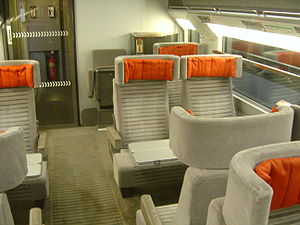British Rail Class 373
| British Rail Class 373 Eurostar e300 TGV TMST |
|
|---|---|

|
|

The interior of a Class 373
|
|
| In service | 1993 - present (Test) 14 November 1994 - present (Passenger Services) |
| Manufacturer | GEC-Alsthom, BN |
| Family name | TGV |
| Constructed | 1992 - 1996 |
| Number built | 31 trainsets (Three Capitals) 7 trainsets (North of London) |
| Number scrapped | 3 trainsets |
| Formation | 20 cars (Three Capitals): DM+MS+TS+TS+TS+TS+TBK+TF+TF+TBF + TBF+TF+TF+TBK+TS+TS+TS+TS+MS+DM 16 cars (North of London): DM+MS+TS+TS+TS+TBK+TF+TBF + TBF+TF+TBK+TS+TS+TS+MS+DM |
| Capacity | 750 seats (Three Capitals) 558 seats (North of London) |
| Operator(s) | Eurostar |
| Depot(s) |
Temple Mills North Pole International (former) |
| Specifications | |
| Car body construction | Steel |
| Train length | 387 m |
| Car length | 18.7 m (61 ft 4 in) (middle) 22.15 m (72 ft 8 in) (driving) 21.84 m (71 ft 8 in) (powered middle) |
| Width | 2.81 m (9 ft 3 in) |
| Maximum speed | 300 km/h (186 mph) (Service) 334.7 km/h (208.0 mph) (Record) |
| Weight | 752 t (740 long tons; 829 short tons) (Three Capitals, empty) 815 t (802 long tons; 898 short tons) (Three Capitals, loaded) 665 t (654 long tons; 733 short tons) (North of London) |
| Power output | 12.2 MW (16,400 hp) (25 kV) 5.7 MW (7,600 hp) (3000 V) 3.4 MW (4,600 hp) (750 V) Tractive Effort: 410 kN (92,000 lbf) Starting @ 25 kV 350 kN (79,000 lbf) Starting @ 1.5 kV & 750 V 220 kN (49,000 lbf) Continuous @200 km/h (124 mph) & 25 kV |
| Electric system(s) |
Overhead lines 25 kV 50 Hz AC 3000 V DC, 1500 V DC Third rail 750 V DC (No longer used) |
| Current collection method |
Pantograph Contact shoe (removed) |
| UIC classification | Bo'Bo'+Bo'2'2'2'2'2'2'2'2'2'+2'2'2'2'2'2'2'2'2'Bo'+Bo'Bo' Bo'Bo'+Bo'2'2'2'2'2'2'2'+2'2'2'2'2'2'2'Bo'+Bo'Bo' |
| Coupling system | Scharfenberg |
| Track gauge | 1,435 mm (4 ft 8 1⁄2 in) standard gauge |
The British Rail Class 373 or TGV TMST train is an electric multiple unit that operates Eurostar's inter-city high-speed rail service between Britain, France and Belgium via the Channel Tunnel. Part of the TGV family, it has a smaller cross-section to fit the smaller loading gauge in Britain, it was originally able to operate on the UK third rail network, and it has extensive fireproofing in case of fire in the tunnel. It is both the second longest—387 metres (1,270 ft)—and second fastest train in regular UK passenger service, operating at speeds of up to 300 kilometres per hour (186 mph). It is beaten in both aspects by the British Rail Class 374, which is 400 metres (1,300 ft) long, even though it has 2 cars fewer, and has a top speed of 320 kilometres per hour (199 mph), though this is never achieved on HS1 in Britain.
Known as the TransManche Super Train (Cross-channel Super Train) during development until start of service in 1993, the train is designated Class 373 under the British TOPS classification system and series 373000 TGV in France. It was built by the French company GEC-Alsthom at its sites in La Rochelle (France), Belfort (France) and Washwood Heath (Britain) and by Brugeoise et Nivelles (BN, now part of Bombardier Transportation) in Bruges (Belgium).
Since the delivery of new Class 374 e320 units from Siemens in 2014, refurbished examples of the Class 373 or TGV-TMST sets have been officially dubbed e300 by Eurostar to distinguish them from the new Velaro fleet.
...
Wikipedia
